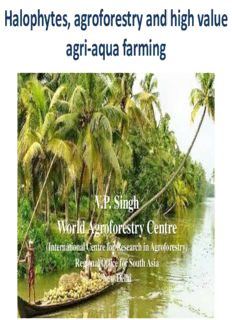
Halophytes, agroforestry and high value agri-aqua farming PDF
Preview Halophytes, agroforestry and high value agri-aqua farming
Halophytes, agroforestry and high value agri-aqua farming V.P. Singh World Agroforestry Centre (International Centre for Research in Agroforestry) Regional Office for South Asia New Delhi Sea Water : A Social Resource Dandi March (6 April 1930) of Mahatma Gandhi Wake-up Call Titanic tsunami of December 26, 2004 Halophytes, agroforestry and high value agri-aqua farming • Can not deal the above as mutually exclusive • What is known is not enough, what is possible is important and looked into, especially with new tools and methods, such as the source of novel genes, etc. • Consider resource use interaction and opportunities among the various enterprises Some common products and systems in coastal- saline environments • Vegetables: Shallots in Ghana, tomato, eggplant across many countries • Fruits: Guava and Ziziphus on the ridges in Thailand, Vietnam, Sonneratia alba in India, Maldives • Rice: Balanta rice in Senegal, Kalrose rice in the Philippines, Pokkali rice in India—waynaad the below sea level farming system—an UN heritage site, Sorjon system in Indonesia, low salinity areas in the Mekong Delta, Vietnam Some common products and systems in coastal- saline environments • Brackish water aquaculture with mangroves in the ponds & pond dikes, and coconuts on the dikes: large scale throughout in South East Asia, small scale in Guinea Bissau, Casamanse Estuary in Senegal, around Keta and Angaw lagoons in Ghana, Marine-aqua– a number of countries • Hyper saline brine shrimp farming: in salt pans in the Philippines, Thailand, and Gujarat, India • Halophytes farming for various uses: large scale in many countries Some common products from coastal- saline environments • Timber, Flowers and Honey from various species • Mangroves as fish shelter and breeding grounds • Bio- drainage / filters, water purifier, ecological services • Biodiversity, nutrient enrichment, etc. Halophytes for multi-purposes • Halophytes are salt-loving plants – growing only in saline areas • Tolerate high concentration of sodium salt; demand high sodium chloride for survival and reproduction; • Have genetic mechanism to tolerate high salinity • They differ widely in salinity tolerance 5 g/l -Sea oats (Hordeum vulgare) 80 g/l -Glasswort (Salicornia spp.) • Can be grown as a cash crop by irrigating with seawater for edible oil, vegetables, flowers, medicinal plants, fodder, etc. Genetic Garden of Halophytes, India No Halophyte species Can be cultivated in seawater 1 Aeluropus lagopoides farming as commercial crops to 2 Arthrocnemum glaucum 3 Arthrocnemum indicum produce edible oil, vegetables, 4 Cressa cretica flowers, fodder, etc. 5 Cyperus conglomeratus Survey along the Tamil Nadu and 6 Halopyrum mucronatum 7 Heliotropium curassavicum Andhra Pradesh resulted in 21 8 Ipomoea pes-caprae species collection and more than 108 9 Porteresia coarctata genotypes 10 Salicornia brachiata 11 Salvadora persica 12 Sesuvium portulacastrum 13 Sporobolus coromandelianus 14 Sporobolus virginicus 15 Suaeda fruticosa 16 Suaeda maritima 17 Suaeda monoica 18 Suaeda nudiflora 19 Tamarix troupii 20 Trianthema portulacastrum 21 Trianthema triquetra Some Important Halophytes in South Asia Arthrocnemum Arthrocnemum Cressa cretica glaucum indicum
Description: